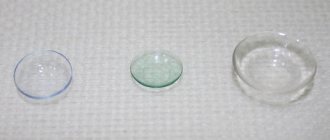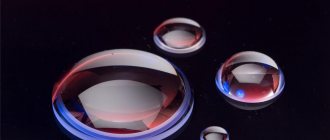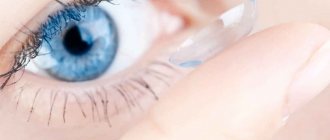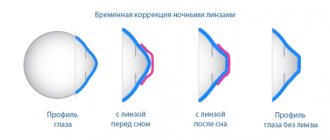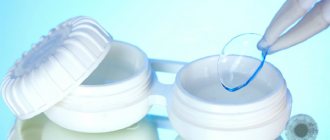Vision correction is now necessary for many, because the load on the eyes has now increased significantly, and this does not help at all to maintain visual acuity. There are now quite a few solutions to this problem, and one of the most modern is night lenses. They are an ideal method for those who are contraindicated for surgery and children. The best part is that these lenses work while you sleep. This type of vision correction is called orthokeratology, in an abbreviated version it can often be found as OK lenses.
What you need to know about such lenses
Myopia is characterized by the fact that light rays are focused not in the retina, as in normal vision, but in front of it. To correct this defect, it is necessary to change the refraction of light rays. This can be achieved by making the cornea flatter. During surgical intervention, it is this principle that is used and taken as the basis in orthokeratology.
Lens structure
Orthokeratology is one of the methods of optometric vision correction. This method uses a rigid lens that presses down on the cornea and makes it flatter, redistributing the top layer of cells that refract light rays. After removing the lens, the cornea retains its given shape for some time, which allows you to have 100% vision without constantly wearing glasses or regular contact lenses. However, this effect is temporary and OK lenses must be worn again.
See what glasses with holes are used for here.
Oak lens structure
The structure of such a lens consists of 2 parts. Its upper part works like a regular lens and a person sees well through them. The inner part has a more complex structure, which affects the eyeball, changing the shape of the cornea.
Even taking into account that this effect lasts up to 2 days, this type of correction has significant advantages over all others.
Benefits of OK therapy
The most important advantage is the refusal to use any other types of vision correctors during the daytime . Glasses or daily contact lenses are not always convenient, and for some they are completely acceptable. Not everyone agrees to undergo surgical intervention and it is not medically possible for everyone. So OK lenses give complete freedom during the daytime.
This material will tell you which lenses are better, daily or monthly.
With constant use of daily lenses, over time, the cornea of the eye begins to suffer from a lack of oxygen; orthokeratology eliminates this problem. All day long, the visual organs receive the necessary oxygen.
Daytime contact lenses often cause dry eye syndrome. This is explained by the fact that the frequency of blinking movements decreases and this negatively affects tear exchange. Tears have protective functions and remove waste products, small particles and microorganisms from the eyes. Night lenses do not cause such disturbances, which is also their advantage.
Decreased accommodation with age
The risk of inflammatory processes in the organs of vision and allergic reactions is reduced. It is also easier to tolerate the period of seasonal allergies without additional irritating factors to the mucous membrane . It is possible to use any cosmetic products, visit the pool and lead an active lifestyle without fear. There is no need to use moisturizing eye drops with hyaluronic acid in adverse weather conditions or heavy smoke. You no longer need to worry that your daily lenses will “dry out” or cause any other discomfort.
If you didn’t like something as a result or process of using OK lenses, then the process can always be reversed. To do this, simply stop using them and the cornea will return to its original shape.
Frequently asked questions about night lenses
- What is orthokeratology?
- What are orthokeratology lenses?
Orthokeratology lenses (OK lenses) are hard night lenses that are worn at night to correct myopia, and in the morning a person takes them off and sees well all day without glasses or contact lenses.
- How long has Orthokeratology been known?
The idea of changing the curvature of the cornea using contact lenses arose in the 60s of the last century. However, only the advent of the latest gas-permeable polymers and laser technology for their processing made it possible to create modern orthokeratology lenses of reverse geometry. The use of lenses of this design for night wear began in 1993.
- Are there age restrictions?
Yes, I have. Orthokeratological or night lenses can be used by adults and children from 6 years of age.
- Are there any contraindications to using night lenses?
Yes, I have. These are inflammatory and dystrophic diseases of the cornea.
- How do night lenses work?
Your child's doctor will select lenses for you. The child himself or with the help of a parent puts on the lenses at night and sleeps in them. At this time, a new, controlled shape of the anterior surface of the corneal epithelium is created, which ensures good vision during the day.
In the morning, the child removes the lenses and lives a normal, full life. It's simple!
- What is the service life of night lenses?
The service life of night lenses is 12 months. After this, the lenses must be replaced with a new pair of lenses.
- How many years in a row can you wear night lenses?
There are no restrictions. You can use night lenses for many years, as long as you replace your night lenses every 12 months.
- Is it possible to break or scratch orthokeratology lenses?
Yes, you can. Orthokeratology lenses are 1% water and 99% polymer. These are hard lenses. They can be broken or damaged if handled carelessly. It is necessary to put on the lenses over the table, slowly.
- What to do if the lens is broken or lost?
Damaged lenses cannot be worn; they must be replaced with new ones.
- What are the benefits of night lenses?
Look at the 3 important advantages of night lenses for children and teenagers:
- significantly slows down the progression of myopia;
- your child walks around all day without glasses or contacts and sees like everyone else;
- gives complete freedom for any type of activity (for example, sports).
- Can myopia be treated with night lenses?
No you can not. Today, unfortunately, there is no way to treat myopia. Orthokeratology gives a temporary effect – for 1 day. Then vision returns to its original state. This is a reversible method of vision correction.
- When can you stop using night lenses?
You can stop wearing nightwear at any time. You can use them for many years. Upon reaching the age of 18, you can undergo laser vision correction or return to glasses or soft contact lenses.
Specifics of wearing mode
The required mode is selected by a specialist. The duration of wear is also determined individually, but usually it is 6-8 hours. The effect will not occur in less time; using it for longer has no contraindications. Depending on the degree of myopia, the effect remains . With a low degree, you can see well for two days, but on average – up to 24 hours. Due to the fact that the person will sleep, the lens itself will practically not be felt.
Always follow the regimen prescribed to you by your doctor! This is as important as choosing the right lenses, and see how to do this here.
It is necessary to put on OK lenses 10-15 minutes before bedtime. If a person works night shifts, then the correction mode depends on sleep patterns, and not on the time of day. The effect occurs immediately after the first use and reaches its maximum after 10-14 days. After which it stays at this level. For mild myopia, a little earlier.
The principle of action of the OK lens
After the first use, you should immediately visit a leading doctor. In this case, the lenses are not removed and you must come to the appointment wearing lenses. The further schedule of visits is determined by the ophthalmologist. Usually at first every week, and then every 3 months. If you experience any discomfort, you should not delay visiting the clinic.
Never miss routine checkups! This is the key to successful correction and health of your eyes!
The lifespan of one lens is quite long - 1-1.5 years. It depends on the material of manufacture, the quality of the lens itself and its care. All the necessary information is specified in the contract concluded with the clinic, and is signed in detail by the attending physician.
The doctor is also required to teach how to care for contact lenses; read this article for some tips.
Benefits of nighttime contact lenses
Night OK therapy has a number of advantages over other methods of vision correction:
- The main thing is that the patient does not require correction at all during the day, i.e. he sees perfectly and is absolutely free from correction devices and any restrictions caused by poor vision.
- In some cases, low vision and means for its correction are unacceptable due to professional activities (pilots, swimmers, hockey players, etc.), and surgical treatment is not possible due to reluctance or medical restrictions. In such cases, therapy with night lenses becomes a real way out of this situation. At the same time, the cornea practically does not suffer from a chronic lack of oxygen (hypoxia), as with constant use of contact lenses, because during the day the patient removes the lenses, and oxygen has free access to the tissues of the cornea. However, it is worth noting that when the eyelids are closed at night, the lenses still cause temporary hypoxia. However, according to experts, after removing the lenses in the morning, its consequences are compensated by the access of oxygen.
- When wearing contact lenses during the day, the frequency of blinking is sharply reduced, and tear exchange is also reduced, which causes the development of dry eye syndrome. In orthokeratology, due to the absence of lenses during the daytime, the physiological mechanism of distribution of tear fluid over the surface of the cornea is preserved, and together with tears, the cornea receives nutrients and bactericidal elements, microorganisms, metabolic products, and the smallest dust particles are washed away.
- Wearing night lenses practically does not cause the development of chronic allergic processes, in comparison with conventional daytime lenses, the risk of conjunctivitis and keratitis is reduced. A person can use any cosmetics - deodorants, hair varnishes and sprays, pencils and mascara for eyes and eyelids, without fear that their particles will remain on the surface of the contact lens.
- Any water procedures become absolutely accessible and safe, because lenses do not need to be removed while swimming and there is no need to wear safety glasses. You can ride your bike or car like a breeze, without fear that your lenses will dry out in the wind.
- There is no need to think about the need to always carry glasses and a container for lenses with you, constantly drip moisturizing drops, refuse to meet with friends if they want to gather in a bar where smoking is allowed. When the possibility of surgical vision correction arises, the patient simply stops using night lenses, and after some time, the cornea takes on its original shape, which is a necessary condition for the operation.
Tips for choosing lenses
Night lenses cannot be purchased at the nearest optician, and their selection should only be carried out by a specialist in the field of orthokeratology. This process is quite lengthy, because a number of special studies are required for the desired effect to be achieved.
Treatment with oak lenses
Main types of diagnostics:
- Identifying contraindications to the use of OK lenses
- Determination of corneal curvature
- Computer examination of the cornea to create a complete “map” of the eyes
- For children, additional studies may be carried out as prescribed by a specialist.
The key to successful correction is a good specialist who will select the right OK lenses.
Only after these studies does the selection of the lenses themselves begin. During the procedure, several pairs may be required to achieve the desired result and be prescribed for permanent use.
The study may reveal a number of contraindications:
- Temporary and chronic inflammatory processes in any part of the visual organs
- Astigmatism exceeding 1.5 diopters
- Protrusion of the cornea and “conical” shape of the eyeball
- Children under six years of age
At first, discomfort and optical disturbances may occur: decreased clarity, photosensitivity, double image.
This occurs during the adaptation period, but if these factors do not go away, you should either replace the lenses or abandon orthokeratology altogether. In any case, you need to consult a professional who will tell you what to do.
Night lenses for eyes: sleep better
Orthokeratology lenses help combat the most common visual impairment - myopia. For Russia, this correction method is young - it has only been actively used for the last 15 years.
Unlike soft contact lenses that are worn during the day, ortho lenses have a more rigid structure and consist of two layers. The top layer works like a daytime corrective lens, and the second layer, the inner one, has a dense and complex structure that allows you to change the shape of the cornea.
These lenses are used while sleeping. The effect is achieved overnight: in the morning the person’s vision returns, and no additional correction methods are required.
Let's find out how lenses work while you're relaxing?
What is the essence of the method?
In people with 100% vision, the image is focused on the retina, while in people who are nearsighted, the image is focused in front of it. But if the optical system of the eye is damaged, then it cannot refract light rays correctly. Night vision lenses, due to their rigidity, correct the shape of the cornea. This occurs due to the redistribution of the upper epithelial layer of cells. Changing the curvature of the cornea helps project images directly onto the retina.
The refractive power of the cornea changes by a strictly necessary amount, so lenses are selected individually.
After sleeping in the lenses, the patient will be able to do without glasses and soft lenses during the day. In two to three days, the cornea will take its natural shape, and the person will return to his previous visual acuity. If you sleep in orthokeratology lenses every night, after a few months you will be able to wear them every other night or even two. And your vision will remain good.
The positive effect is achieved gradually. In the first days, lenses worn at night restore vision up to 75%, after two weeks - up to 100%.
Why at night?
Unlike glasses and soft contact lenses, night vision restoration lenses do not compensate for refractive errors directly during use. They “work” for the future.
Sleeping time is the most convenient period for achieving the desired optical effect, because you need to wear orthokeratological contact lenses for at least 8 hours.
You need to sleep in night lenses for at least eight hours!
Important: lenses must be used regularly. After all, over the course of a day, the cornea gradually takes on its original shape.
Can night lenses cure myopia?
Orthokeratology is the only non-invasive method that can stop the progression of myopia. Night lenses for vision correction prevent the eyeball from growing further. They create a gentle “bandage” for the cornea and prevent it from bending. This can stop vision loss in children with progressive myopia.
But there is no point in hoping that night lenses can cure myopia.
Nighttime orthokeratology lenses affect only the most superficial layer of the cornea, without exposing the deeper layers of the eye. Therefore, the effect of the lenses is reversible and the lenses last only as long as you use them. Once you stop wearing nighttime lenses to restore your vision, the effects will decrease and then disappear completely.
Alexander Padar, founder of the Omicron network of ophthalmological clinics
Orthokeratology is only gaining popularity. Information about her is constantly surrounded by various myths. What is true and what is false - we have already figured out in a separate article.
Now let’s look at who and why should pay attention to this correction method.
Advantages of night lenses:
- Nighttime corrective contact lenses help slow the progression of myopia. Glasses and soft lenses do not have this property;
- Suitable for children. Provides them with good vision without glasses and contact lenses during the day. They will not hinder their activity and prevent them from playing various sports;
- Helps get rid of the “bespectacled” complex;
- They serve as an alternative to glasses and lenses for those who do not want to wear them due to their professional activities: military personnel, pilots, athletes.
- They are not addictive and have a reversible effect. You can stop using nighttime contact lenses for vision correction at any time, and your vision will return to its original level. After them, you can switch to contact lenses, glasses, or get rid of myopia using laser vision correction.
Orthokeratology lenses are not addictive
You should think about choosing night lenses if you have:
- myopia up to 6 diopters;
- astigmatism up to 1.5 diopters;
- there is a ban on laser vision correction or professional restrictions on lenses and glasses.
Despite all the advantages of night lenses, this method of vision correction is not suitable for everyone.
About contraindications
Diseases of the conjunctiva, cornea and eyelids are a contraindication to the use of orthokeratology lenses.
People with dry eye syndrome and astigmatism of more than 1.75 diopters should not choose night lenses either. Are night lenses right for you to improve your vision? This can only be determined by a doctor during diagnosis.
In ophthalmology, orthokeratology lenses are selected free of charge. The entire procedure, from consultation to purchasing lenses, will take only two hours.
Waiting for you!
Tips for caring for lenses
Caring for hard lenses is not much different from caring for day lenses. The process of putting on and taking off is identical. Sometimes, to remove the lens from your eyes, you need a special tool, but if you can do it without it, then you can dispense with it.
For care, you need a special container in which the lens will be stored, cleaning and storage products. The container has a special shape and the lens is stored in a vertical position. Lenses should be cleaned daily, and deep enzymatic cleaning should be done once a week. Every morning, before placing in the container, vision correctors should be rinsed with contact lens solution. The doctor will prescribe it, taking into account the sensitivity of the eyes and the material of the lens itself.
Do not select the solution yourself! This can cause irritation, inflammation in the organs of vision and damage the lens!
Deep cleaning is most often needed once a week, but a customized schedule can be created. This depends on the metabolic rate of the organs of vision and the degree of excretion of output products . If the lens becomes cloudy or has any particles on it, it should be deep cleaned.
If you experience any discomfort, seek advice immediately! Neglect can lead to inflammatory processes!
Make sure that the lens does not become deformed, that chips or cracks do not appear on it, so do not drop them on hard surfaces. Do not use liquids that are not intended for lens care. During an illness accompanied by high fever, it is recommended not to use orthokeratology. The body is already weakened, so there is a possible risk of developing inflammatory processes.
This link will tell you what the appearance of red spots under the eyes means.
Always keep the container clean and the OK lens clear.
Rules for putting on lenses
- Fill the containers in advance so that the removed lens can be removed immediately and without unnecessary delays. The less she is outdoors, the better.
- It is strictly forbidden to rinse and store lenses in plain water. There are special solutions for this, and your ophthalmologist will help you choose one. These liquids have disinfecting properties, while ordinary water not only does not kill microorganisms, but is itself teeming with them.
- Rinse the removed lens on both sides with the solution and rub gently with your finger for 10 seconds. The accuracy of the mechanical action is very important here, since we are talking about a surface in contact with the eye. It is necessary to clean off protein accumulations without damaging the correction product.
- Place a clean lens in the container and immediately screw the cap on to avoid accidental dust from the air, then proceed to remove the next one.
The following picture shows the main points that must be observed when properly caring for lenses:
conclusions
Orthokeratology has not yet become widespread in Russia. The method is still quite new for our country, but very promising. This is an excellent opportunity to reduce the rate of vision loss in children and adolescents who are not yet eligible for surgery. This method also allows you to freely lead an active lifestyle, without limiting yourself to other types of contact vision correction for farsightedness or myopia. This is extremely convenient for many people.
Read also about hard night lenses here.
Every year there are more and more people using contact lenses. The lenses are easy to use, they minimize the risk of eye injury, they are easy to use
store, use and take with you. In this regard, there is a need to know not only how to choose the right lenses in order to maintain eye health, but also how to monitor the shelf life of the product and replace it with a new one in a timely manner. We will talk about the useful life of contact lenses and the unsafety of using an expired product in this article.
Unfortunately, many people believe that lenses do not have an expiration date, and the product can serve us indefinitely, exactly until we ourselves see changes in vision when wearing them. Some people prefer to change lenses only when they no longer notice any visible effect from their use. But relying only on your own feelings is wrong. Any lenses have their own expiration date, after which their use becomes unsafe for the eyes. The standard service life of lenses is four years from the date of production, if the packaging is unopened. Until the expiration date, the manufacturer guarantees the safety of the product. The expiration date in the “year/month” format is printed on the foil cover of the product. It is also worth mentioning here that as soon as you open the package with a sterile saline solution, it ceases to be such, and accordingly, you cannot put the lenses back and store them again.
In addition to the expiration date, the following characteristics are indicated on the foil cover of the product:
- lens diameter;
- base curvature;
- optical power of the lens;
- the material from which the product is made;
- manufacturer's name and lens brand.
To avoid unpleasant situations when purchasing lenses, be sure to pay attention to the expiration date of the product. Then, after opening the manufacturer's packaging, you can store the lenses in a special container, adding saline solution.
Using lenses for a longer period than specified by the manufacturer may result in the development of various eye diseases. Microbes and bacteria that appear in expired material directly interact with the mucous membrane of the eye, which causes irritation, redness, tearing and burning. If you do not pay attention to these unpleasant symptoms in time, irritation develops into inflammation of the eyes, discharge of pus and the appearance of swelling. To prevent this from happening, we advise you to take care of yourself, monitor the expiration dates of products and related products, and systematically seek advice from a specialist.
